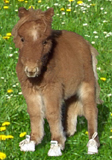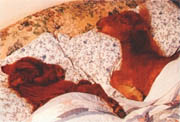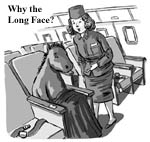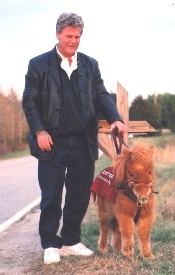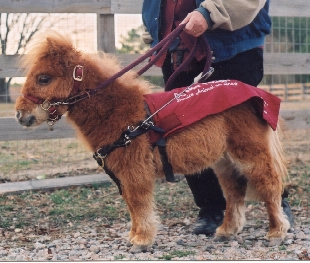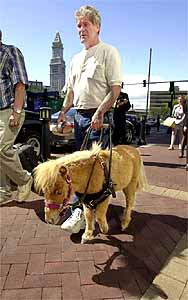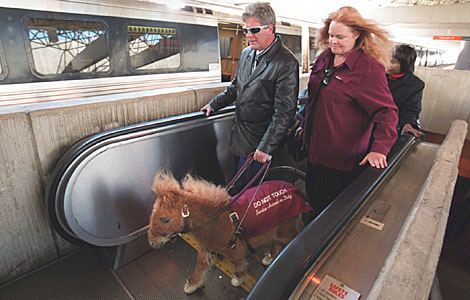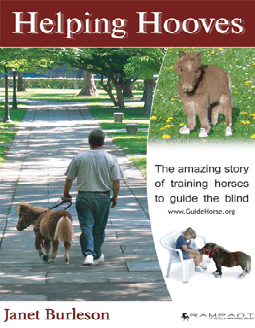|
|
A Little Horse Sense: One Family’s Innovative Approach to Helping the Blind BY LINDA PETERSON Biography Magazine
During a 1998 business trip to New York City, computer consultants Janet and Don Burleson decided to go horseback riding in Central Park. On the walk from the stable to the park, the couple noted their rental horses’ calm demeanor amid the chaotic Manhattan traffic. They also noticed hoe the animals sensed on their own when to cross traffic. As a trainer of Arabian show horses for 30 years, Janet was no stranger to equine behavior. But the urban experience got her thinking—especially about one of their pet miniature horses on their farm in Kittrell, North Carolina. Affectionate and companionable, two-foot-tall “Twinkie” often followed the Burlesons around like a dog, and even rode happily in the back of their minivan. Janet also remembered, as a young girl, once watching a blind rider compete in horse shows. “The woman gave the horse directions, and it took her around the obstacles and the other horses in the class,” she recalls. “It was serving as her guide and was something I’d never forgotten.” Piecing all this together, Janet started wondering: Could a miniature horse be trained as a guide animal for the blind? She already knew that horses had intelligence, strength, and stamina, superior eyesight—nearly a 350-degree range of vision—and excellent long-term memory. “Once they learn a task,” she notes, “they never forget it.” Another plus: Someone allergic to dogs would be unlikely to have the same reaction to a horse. Back home in Kittrell, Don fashioned a harness with a handle, and with repetition as the key, Janet began teaching Twinkie to obey basic voice commands such as “forward,” “right,” and “slow.” She tried to steal an hour or two from their computer firm and their other business on the farm, breeding Arabians. Over months of research, Janet read whatever she could find about guide animals and training method, and also got help from orientation instructors for the blind. Karen Clark, a blind woman from Raleigh who had a guide dog, volunteered to walk with Twinkie and give feedback on what the handler needed to get from the animal. Out on the streets and sidewalks, Twinkie learned to signal her handler about changes in elevation (such as steps and curbs) and to recognize hazards like overhanging branches or a pothole. And, in the same way the police train their horses, Janet taught Twinkie to “spook in place” by exposing her to a lot of loud stimuli, so she ultimately learned not to be distracted by noises and crowds. “Absolutely the biggest challenge is the traffic training,” says Janet. “We have to teach the horse how to keep a person safe in traffic. The person makes the decision to go, but the animal advises the person whether or not it’s safe to go.” At an indoor shopping mall in Raleigh, wearing the tiny leather booties Don sewed from baby shoes to keep her hooves from slipping on the smooth floor, Twinkie learned to negotiate an escalator and elevator. At a local restaurant, she was trained to stand under the table and nap while her owners ate lunch. And she was housebroken within a week—tapping her hoof at the door when nature called. As word spread about the unique little hors, local media began to do stories, and the Burlesons appeared on TV’s Ripley’s Believe It or Not. Given Janet’s lifelong love of horses, it isn’t hard to believe. Growing up in the suburbs of Charlotte, she got her first pony at age 8 and began training Arabians when she was still a teenager. In 1998 she married fellow animal lover Don Burleson, one of the world’s experts on Oracle database administration. “I was a Web site developer, and he wrote a book about Oracle databases on the Web,” Janet explains. “I had e-mailed him a question and we started exchanging e-mail. We discovered we were living about a mile from each other in Raleigh and decided to meet. It was Janet’s first marriage and the second for Don (both are 48), who is the father of two teenagers, Andrew and Jennifer. When the couple began living on the farm, they got their first pair of miniature horses, “to be lawn ornaments and great little lawn mowers,” Janet laughs. But as the experiment with Twinkie progressed, Janet began to believe that the minis could be so much more. From his early childhood on, Dan Shaw came to expect a hard-knock life. His parents divorced when he was 4, his father “took off,” and he and his mother left his native Oregon for Lynn, Massachusetts. After his mom remarried and had four more sons, Dan felt pushed away by his stepfather. The rebellious boy was sent to reform school for three years, “and then I was passed around foster families.” One bright spot was a summer he spent at a camp for disadvantaged kid, where he first encountered—and fell in love with—horses. “I’d daydream about how I’d run off with one,” recalls Dan, now 47 and a resident of Ellsworth, Maine. When he was 17, Dan learned he had an inherited eye condition, retinitis pigmentosa, that would eventually take his sight. (His brothers had the same condition.) And the hard knocks continued: After marrying at 19, he lost his firstborn to crib death. He later had two children, Danny and Jessica, but his marriage failed. Angry that “everything was not fair,” he lived in denial. He wouldn’t admit that he had trouble seeing because, he says, “people treated you different. They stopped coming around, they stopped being friends.” Still a rebel in his 20s with tattoos covering his arms, he rode his motorcycle—sometimes with the Hell’s Angels—even as his vision deteriorated. He bounced from job to job because he’d get fired when he couldn’t keep doing the work. It was until his early 40s—with only 5% vision left—that Dan began to make concessions. He attended a Boston school for the blind, where he quickly began to read Braille—and, after graduation, began teaching it to sighted children “so they can relate to a blind kid in school.” A craftsman most of his life, he was taught to use his woodworking tools with adaptive devises so he could still build things like birdhouses and arbors. An avid fisherman, he opened a bait and tackle shop out of his garage. But his problems in public continued, due to his admittedly stubborn refusal to use a cane. In a restaurant he’d bump into a table and spill someone’s drink; in a grocery store he’d stumble over little kids and get blasted by their irate parents. Eventually he was afraid to go out at all. Ann, his second wife, of 17 years (and mother of his stepchildren, Larry and Kelly, was growing increasingly frustrated, and was tired of worrying about him while she was at work. “He kept hurting himself to the point where I finally said, “This is it—you need to do something now,” she recalls. She had brought up the idea of a guide dog before, but Dan resisted, knowing their life expectancy was fairly short. But at Ann’s urging, he gave in. And so it was that one day in March 2000, the couple was sitting at the kitchen table filling out a guide-dog application with the TV on in the background. Suddenly, Dan heard the words, “guide horse for the blind.” It was the Ripley’s Believe It or Not program about the Burlesons. “Ann,” Dan said excitedly, that’s what I want!” He was especially intrigued to hear that the average lifespan of a miniature horse was 30 to 40 years, which meant he might be able to have just one for the rest of his life. He tracked down the Burlesons’ phone number and became the first person to ask them for a horse. Or as Janet puts it, “Dan volunteered—he begged, actually—to be the first guinea pig. We told him we were still testing the concept, but he pretty much talked us into going to the next step.” A few months later, their newly formed Guide Horse Foundation got a $30,000 donation from bestselling mystery writer Patricia Cromwell. (She has visited their farm several times, and her recent book, Isle of Dogs, includes a character who uses a guide horse.)
The money allowed the Burlesons to buy six of the smallest miniatures, called pygmies (costing $2,000-$6,000 each, or more), one of which they names Cuddles and designated for Dan. Over the next year, Dan called every week to check on the 24-inch tall (measured at the shoulder), 55-pound chestnut mare. Finally, in March 2001, he flew to Raleigh for a preliminary visit. As Dan came off the plane, the Burlesons were waiting with Cuddles. Dan leaned over to pet her and got a lick in the face—and felt an instant bond that brought tears to his eyes. The new team took their first test outing in a pet store, where boxes were piled high in the aisles—and Cuddles deftly maneuvered Dan past them all. Overwhelmed at his newfound sense of freedom, Dan began to cry once more. In May he returned for a month of intensive training, then he, Cuddles, and the Burlesons all headed to his home. The trip back to Maine included a stop in New York City, where Dan and his pint-size partner successfully negotiated the subway and visited the Statue of Liberty (Cuddles ate some of the lawn for lunch). “She never got nervous,” says Dan of their Big Apple adventure. “She never flinched. She kept me safe.” The Burlesons spent a week at Dan’s home getting the new team settled in, and they also provided another min, Nevada, who keeps Cuddles company when she’s off duty. In this rural backyard, Dan built “my babies” a corral and a tiny barn—complete with a heated water pail and, yes, their own TV. “Cuddles likes to watch the news because she’s been on it much,” he jokes. Nearly two years into their partnership, Dan reports that Cuddles has never spooked on him or lost her focus in any way. “When I put her harness and equipment on, she’s like a little soldier,” he says”[But] when it comes off, she’s just a regular little horse. She’ll so play with Nevada.” And thanks to Cuddles, Dan—whose newest tattoo is of his miniature horse—feels like a regular guy for the first time in years. “My life has opened up with this little horse,” he says. When they’re not taking long walks in the woods or fishing at his pond, Dan and Cuddles often visit schools, or make presentations to civic groups to raise money for the Guide Horse Foundation. “Dan keeps himself pretty busy and is always out helping somebody,” says Ann, who no longer worries about her husband. Cuddles have brought us a lot of joy.” The 80 blind people on the Burleson’s waiting list hope to experience that joy someday, but they’ll have to be patient. Janet is training nine horses but can volunteer only part-time, assisted by Don and her brother John Lavender. Early this year, a car accident left Janet with a broken wrist, delaying the placement of the next guide horse with a Pennsylvania woman, now planned for this fall. At some point, Janet hopes that the Foundation will be able to hire other people to train the minis full time. In the meantime, she stresses, her guide horses “are not intended to replace guide dogs or compete with them. We’re just offering a new option for a blind person.” LINDA PETERSON IS ASSOCIATE EDITOR OF BIOGRAPHY MAGAZINE.
|
Guides Training Press Photos News Apply FAQ Wishes Contact Home
|
|
Copyright © 1998 - 2005 by the Guide Horse Foundation Inc. Guide Horse ® Guidehorse ® and Helping Hooves ® are registered trademarks. |
The Guide Horse Foundation has the utmost respect for The Seeing Eye® and their seventy-two years of outstanding work with assistance animals for the blind. Even though the press often calls our horses "seeing eye horses", please note that The Guide Horse Foundation is not affiliated with or sanctioned by the Seeing-Eye® or any of the Guide Dog training organizations. Seeing-Eye® is a registered trademark of the Seeing-Eye, Inc.
